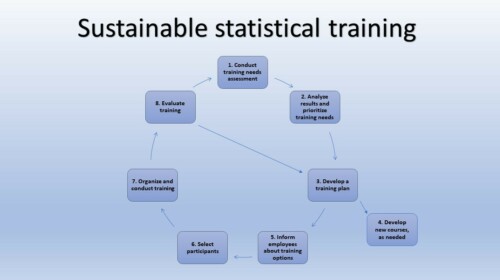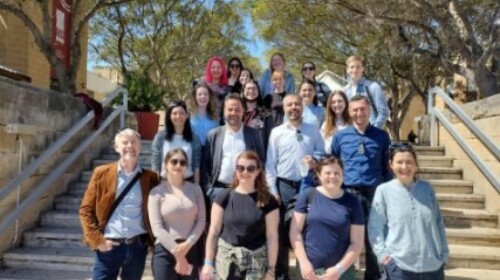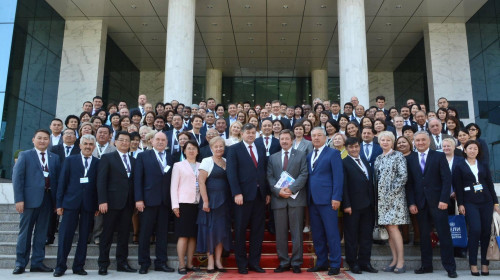The quality of a country’s official statistics depends to a large degree on the capabilities of the staff working in the national statistical system. Making sure that staff has adequate skills is crucial and should be a priority of those institutions working with the production of official statistics. Training in needed skills can improve performance and productivity and help the institutions meet both current, new, and future requirements. For the individual staff, more competence may give more satisfying and interesting work and increase responsibility. Training is an investment, and it will initially cost the working hours of the staff, but the expected return is more skilled, efficient, and motivated staff.
The Global Network of Institutions for Statistical Training (GIST) (https://unstats.un.org/GIST) was established in 2018 with the aim to contribute to efficient, effective, and harmonized delivery of statistical training and has in recent years worked on efforts to meet training requests of national statistical offices. A review has been conducted on how different national statistical offices approach and organise training for their staff. The analysis showed a large variation in national statistical training programmes and even a lack of a strategic approach to training in some countries. The lack of national sustainable training programmes has implications for the skill levels of staff and the ability of the national statistical office (and other institutions within the national statistical system) to develop and modernize and to meet the increasing needs of users.
GIST thus recognized the need for a tool, which can help national statistical offices:
- Taking the lead in prioritization training provided to the staff, thus ensuring a holistic approach to training rather than providing training more ad-hoc based on offers available from partners
- Identifying the needs and gaps in skills from both a staff member and a strategic managerial perspective
- Prioritizing among staff’s different (and presumably many) training needs
- Meeting needs through own or freely available resources and support from national and international partners
The Statistical Training Assessment Tool
The Statistical Training Assessment Tool, also known as STAT, has been developed by GIST and is intended to support national statistical offices in identifying, assessing, and meeting prioritized training needs. STAT consists of three questionnaires to assess skills levels and training needs at the national statistical office and within the national statistical system. It also provides a guidance document to support the prioritization process and establishment of a national training programme.
GIST wanted to provide a tool, which the national statistical office can manage by itself. Hence STAT is owned by the national statistical office and should be locally adjusted as needed. The tool will help the national statistical office to think more strategically about training and how to set up a training programme based on staff needs. STAT further provides recommendations on how the national statistical office can prioritize among the many training needs and how to meet those needs by looking at the provision of training more broadly. The tool thus aims to inspire the national statistical office to consider both informal and formal training and the use of different training formats (online training; in-person training; self-paced training etc.). STAT can also help the national statistical office identify those training needs where support from partners such as regional and international organizations, bilateral donors, academia etc. are needed.
STAT provides an option for the national statistical office to assess skill levels and training needs within the national statistical system and support those statisticians working in the different ministries and agencies. This is particularly important for those countries where a large part of the statistics production lies with other institutions than the national statistical office.
Besides focusing on the needs of staff working in statistics production, STAT also looks into the skills and training needs of staff working in administrative functions such as finance and HR. A well-functioning organization is highly dependent on efficient and smooth administrative procedures and is also key in the management of the national statistical system.
The three questionnaires address different respondents and purposes:
- A questionnaire for all staff including managers at the national statistical office to identify the individual level of a range of skills and the training needs.
- A questionnaire for managers at the national statistical office to identify gaps in their team’s ability to perform current as well as future tasks. The questionnaire is intended to capture institutional needs based on priorities and strategies and expected future requirements.
- A questionnaire for staff working with statistics production at other institutions within the national statistical system (i.e. ministries and other public institutions).
The questionnaires are developed to capture a wide range of different and cross-cutting skills. Since skills requirements can vary from country to country, the questionnaires are designed to be flexible, and can thus be accustomed to meet the specific requirements of the country by deleting or adding skills or sub-sections.
STAT is still in an early stage and is currently being piloted before a final version will be made available at the end of 2023. The national statistical offices in Colombia, Ghana, Maldives, Malawi, Mexico, and Papua New Guinea have kindly offered to pilot the tool.
How to develop a national training programme
Deciding on which training needs to prioritize and include in a training programme of the national statistical office is not an easy task. If the training needs assessment has been conducted, the result will most likely show that staff have many different training needs. The national statistical office therefore needs to prioritize among those skills and assess which are most crucial and beneficial for the organization. There are several considerations to take, and some considerations may even be in conflict with others.
Considerations include among others:
- The needs of the many staff vs few staff
- Training identified as high vs low priority by respondents
- Staff vs management identified needs
- Very few staff lacking knowledge in key skills
- New and inexperienced staff vs experienced staff
- The need for improvement in basic vs intermediate vs advanced skill levels
Once the national statistical office has the list of priority training, it has to decide on how the needs can be met. It therefore needs to consider what is already available, what is possible, what can be done in-house or with support from external partners and institutions.
Training should be understood as a broad term including both informal and formal training. Informal training includes on-the-job training, mentoring and participation in networks, while formal training includes facilitated and self-facilitated training as well as reading. Usually, the majority of training will be on-the-job training, while formal training will make up a smaller share of training for the individual.
Lack of funding is often a challenge to meet all training needs. However, the national statistical office can develop a training programme even with limited funds. Focusing on informal training such as on-the-job-training, mentoring and free e-learning as well as offering a few facilitated courses is a way to get started without making the task too overwhelming or costly.
Face-to-face training has long been the preferred method of learning. However, offering e-learning expands the opportunities and is better than no training at all. The national statistical office can prioritize face-to-face training when personal interaction is crucial for the learning outcome.
The national statistical office should also consider using staff as trainers as it has many advantages. It strengthens the self-sufficiency of the organization, provide development opportunities for staff and target training to the specific needs of the organization. Thus, building a culture where staff are motivated and supported to train others is beneficial for the organization.
Training new staff is a crucial discipline
New staff will usually be more engaged in training than more experienced staff. Since new staff will always continue to arrive in the organization, it is important to offer a set of basic training courses for new staff - even by the use of free e-learning that could be supported by an in-house facilitator to engage in discussions and clarifying questions.
Newly recruited staff can be trained in the basics of official statistics, data analysis, data presentation, dissemination techniques as well as the organisation and administrative procedures of the organization. Preferably, new staff should receive training within the first year and should be given the time needed during working hours to engage in training activities whether informal or formal.
If the national statistical office has limited resources to develop training materials, it can use free e-learning to train new staff. STAT has identified a list of topics that new staff would normally need training in and has also identified relevant free e-learning resources.
What does it take to meet the training needs of staff?
Management must be supportive of staff prioritizing training and devoting the needed time. Integrating training as part of the ordinary tasks of staff may facilitate this process. If giving and attending training is something that has to be done in addition to other tasks, it may not receive the needed attention.
Moreover, management often has knowledge of existing competencies but also the needs of tomorrow and should therefore be actively engaged in identifying training needs. Management can in addition play an active role in dialogue with individual staff about his/her specific training needs thus supporting the individual in fulfilling roles and responsibilities.
Training should be considered a normal part of work and should in principle take place during working hours. Participation in training during working hours might also give female staff better opportunities to benefit. Both learners and in-house trainers need to set aside time for training and be able and willing to prioritize it over other tasks.
In general, promoting an organisational culture of training, using more experienced staff to train others, and focusing on training as a broad concept, will, in the long run, make the national statistical office and possibly the national statistical system more self-sufficient and able to meet society’s need for high-quality statistics. Skilled staff are just more capable of carrying out their job.
* Ms. Charlotte Juul Hansen, Consultant, United Nations Statistics Division/DESA
in collaboration with the Global Network of Institutions for Statistical Training (GIST)
Charlotte Juul Hansen has worked for the United Nations Statistics Division in the past years. She has developed the Statistical Training Assessment Tool in cooperation with the Global Network of Institutions for Statistical Training (GIST). She has previously worked in Statistics Denmark managing statistical capacity building projects in developing countries and in UNFPA on reproductive health-related topics.








